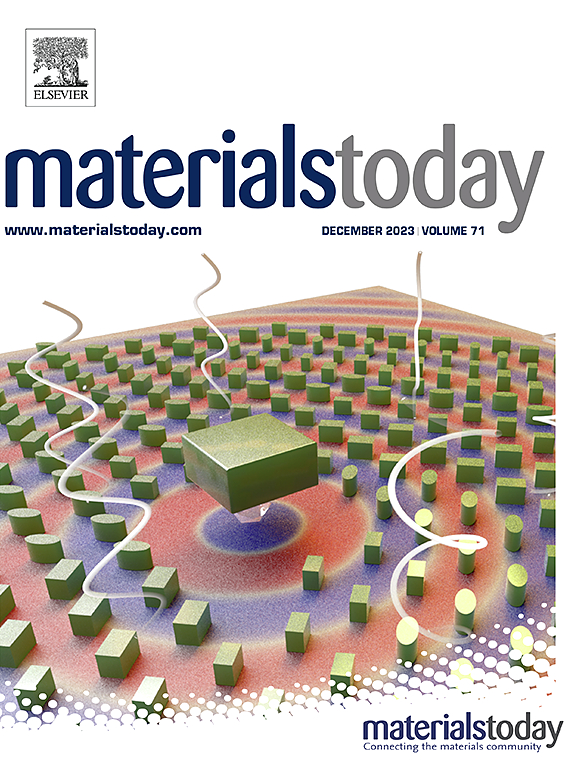热触发的线粒体氧化磷酸化增强纳米药物使铜protosis增敏,增强抗肿瘤免疫
IF 21.1
1区 材料科学
Q1 MATERIALS SCIENCE, MULTIDISCIPLINARY
引用次数: 0
摘要
cuprotosis是一种程序性细胞死亡(PCD)形式,依赖于线粒体呼吸,由铁氧还蛋白1 (FDX1)驱动,由于Warburg效应,显示出有限的抗肿瘤功效。为了突破这一局限,我们首先发现cuprotosis与热刺激高度相关,因为热刺激有利于改善肿瘤线粒体氧化磷酸化。在此基础上,通过将两种fda批准的药物吲哚青绿(ICG)和埃来氯莫尔(ES)包被到基于右旋糖酐的共聚纳米载体中,开发了一种热响应线粒体代谢调节纳米药物(DIE)。DIE富含二硫键,这有利于消耗谷胱甘肽并确保铜还原所需的细胞毒性Cu (I)浓度。在近红外激光刺激下,DIE通过增加线粒体还原酶fdx1介导的脂酰化蛋白聚集和氧化磷酸化,显着使黑色素瘤细胞对铜变性敏感。此外,铜增生的增强进一步诱导免疫遗传细胞死亡,进而提高PD-L1免疫检查点抑制剂的疗效,显示出良好的肿瘤抑制和转移抑制作用。本研究提供了一种使癌细胞对铜增生敏感的新方法,并为肿瘤免疫治疗提供了一种协同策略。本文章由计算机程序翻译,如有差异,请以英文原文为准。

Thermal-triggered mitochondrial oxidative phosphorylation-enhanced nanodrug sensitizes cuproptosis with amplified anti-tumor immunity
Cuproptosis, a form of programmed cell death (PCD) dependent on mitochondrial respiration and driven by ferredoxin 1 (FDX1), has shown limited antitumor efficacy due to the Warburg effect. In order to break through this limitation, we first discover that cuproptosis is highly correlated with thermal stimulation because thermal stimulus is beneficial for improving tumor mitochondrial oxidative phosphorylation. On this basis, a thermal-responsive mitochondrial metabolism-regulable nanodrug (DIE) is developed by encapsulating two FDA-approved drugs, indocyanine green (ICG) and elesclomol (ES), into a dextran-based copolymeric nanocarrier. DIE is rich in disulfide bonds which are advantageous for depleting GSH and ensuring the cytotoxic Cu (I) concentrations required for cuproptosis. Upon near-infrared laser stimulation, DIE significantly sensitizes melanoma cells to cuproptosis through increasing mitochondrial reductase FDX1-mediated lipoylated protein aggregation and oxidative phosphorylation. Moreover, the enhanced cuproptosis further induces immunogenetic cell death and subsequently improves the efficacy of the PD-L1 immune checkpoint inhibitors, demonstrating excellent tumor suppression and metastasis inhibition. This study offers a novel approach to sensitize cancer cells to cuproptosis and provides a synergistic strategy for tumor immunotherapy.
求助全文
通过发布文献求助,成功后即可免费获取论文全文。
去求助
来源期刊

Materials Today
工程技术-材料科学:综合
CiteScore
36.30
自引率
1.20%
发文量
237
审稿时长
23 days
期刊介绍:
Materials Today is the leading journal in the Materials Today family, focusing on the latest and most impactful work in the materials science community. With a reputation for excellence in news and reviews, the journal has now expanded its coverage to include original research and aims to be at the forefront of the field.
We welcome comprehensive articles, short communications, and review articles from established leaders in the rapidly evolving fields of materials science and related disciplines. We strive to provide authors with rigorous peer review, fast publication, and maximum exposure for their work. While we only accept the most significant manuscripts, our speedy evaluation process ensures that there are no unnecessary publication delays.
 求助内容:
求助内容: 应助结果提醒方式:
应助结果提醒方式:


